Ten years ago
I joined my friends Mike & Larry (they’re brothers) on a week-long vacation in Playa del Carmen, Mexico. One of our main purposes was to do some scuba diving and escape the long winter we’d endured. Over the course of our trip, we had some memorable adventures, and we weathered a couple of misfortunes too.
The “fun” started with our departing flight. It was delayed, due to human error. Check out the full story and my other stories about missed connections in this blog post.
But the short version of the story is that one of the airplane’s antennas was knocked off by the baggage conveyor truck! This forced a delay while another plane & crew were flown over from the airline’s head office in Toronto to pick us up. It took hours, but eventually, we boarded our flight south. We were meant to arrive at our resort in the morning, instead, we arrived after dark. I remember eating some cold, mediocre food from the “late buffet”, and wondering what our surroundings looked like.
The next morning, we awoke to beautiful views of palm trees and an inviting beach! Also, the food was better when it was served fresh and hot. I am usually one of the two colors of my national flag, especially when I go on vacation. For my international readers, our Canadian flag is red & white. I am usually too pasty white from the long cold winter with little sun exposure, then I get a sunburn from our first good day of sunshine because I want to soak it all up! It takes a lot of effort for me to get a good, proper tan. In our exuberance to enjoy the sun, that first day all three of us got sunburnt! All week we had wonderful sunny, hot days.

Later that day, we walked to town, and found a dive shop where we booked some diving for the next 3 days. (I was a pretty new diver, with only 7 open water dives under my belt so far. Over those 3 days of diving, I doubled my experience with 7 more dives.) After, to celebrate and cool down, we stopped at a restaurant on the beach and ordered a bucket of Corona beer. We spent a bit more time exploring the town before we headed back to our resort.

Diving Stories:
I logged quite a few firsts on this trip!
I had the opportunity to do my first deep dive,
wherein I got down to a max of 114 feet. There’s a phenomenon called nitrogen narcosis, nicknamed “getting narced.” Here’s the short explanation: it’s caused by breathing inert gasses (like nitrogen) at higher pressure; and it can induce an altered state of consciousness, similar to alcohol intoxication. This condition only happens while diving at a depth of 30 meters (100 feet) or deeper, and is reversed when the diver ascends above that. But exactly how and when it happens can appear to be random, not always happening at the same depth for each diver. For more information, check out this article.
While preparing for my deep dive, I was concerned about getting narced. Mike assured me that if it happened, he would look after me. I had a great first deep dive, and I didn’t get narced at all. In fact, to this date, I have never gotten narced!

I also completed my first night dive on this trip.
You may think that idea sounds scary, but it isn’t. In fact, the way that our divemaster set up this dive, which he knew was going to be my first night dive, was pretty amazing. It was a good way to ease me into diving in the dark. See, he outfitted us with flashlights, but we kept them off as he took us out diving when it was near dusk, and there was still plenty of light from the sun. Then, as our dive progressed, it gradually got darker, until we eventually turned on our flashlights when we needed them. By the time we completed our dive, it was completely dark.
At the time of this writing, I have 155 dives, and I am completely comfortable diving into dark water. Not only am I comfortable, but I look forward to it! I owe it all to how well my first night dive went, thanks to that Divemaster in Mexico.
However, the new diver that I was learned a couple of valuable lessons on that dive too! These lessons were “ALWAYS stay close to your dive buddy”, and “NEVER get so distracted by something you’re seeing or observing that you lose track of your buddy and group”!
I have always been interested by octopi, but hadn’t seen any with my own eyes yet. I was really hoping to see one on our night dive. Our divemaster didn’t offer too many night dives, so when we asked to do one, he told all his friends. The group of us that went out for that dive was so big that he split us into two groups. He would take us, his paying customers, and a couple of others with him, and the rest of the group would follow a couple of minutes behind us. The dive started great and was progressing fine. Here is a good time to mention that I didn’t have my own gear yet, and the light that I was renting was very dim. Before we started the dive, we went over the way we would communicate while diving, using hand signals in the light, and certain motions with our flashlights in the dark.
Once it was fully dark, I eventually found my first octopus, and was very excited! I showed Mike, then I attempted to get our divemaster’s attention, but I was unable to do so with my dim light. Nevertheless, I stayed and continued to watch that octopus. I was fascinated and enchanted, and frankly, I zoned out and lost track of time. This was a dream come true, the biggest thing I wanted on this night dive was to see an octopus! Eventually, there were more divers and lights around me. Assuming that my divemaster had come to see, I excitedly pointed out my find. One of them took some pictures. Only then, I realized that this wasn’t my group! I wondered what had become of them? When I looked around, I saw in the distance the dim lights of a group, and I quickly swam to join them. I was relieved that it was my group and to be back with them, and my dive buddy. Mike had started to look for me, and was relieved too. He made it clear, via motions, that we were supposed to stay close together. Only once we were back on the surface, and everybody was able to talk about it, did we truly discover what had happened. I had stayed there at that octopus so long that the second half of our group came upon me. There were some appropriate stern words spoken, where the lesson to always stay with your buddy while diving was hammered into my brain. I am thankful that everything turned out ok, and I will never forget the lessons I learned while diving that night!

They also had a little bit of bioluminescence in that area at that time, which was fascinating. Different species create different colors, and in the ocean blue is one of the most common. But that day we saw green bioluminescence. One of the ways that bioluminescence occurs is when microscopic plankton is disturbed. Check out this article from National Geographic for more information. That evening, it was explained to us that over the course of the day this plankton absorbs energy from the sun, planning to slowly expend it during the night. But if they are disturbed, then they quickly expend some of their energy as a dim green glow. For us to see this, we had to disturb them by vigorously waving our hands or kicking our feet in the water, while our lights were off. Actually, as a safety precaution, we didn’t turn our lights off; we just pressed them against our wetsuits to prevent their light from shining in the water while we experimented with disturbing the plankton to get them to glow. What happened was that our motion created little bubbles, and they glowed for 1-2 seconds. I was fascinated! I have never seen natural bioluminescence before or since, but I hope to see it again one day.
Another unique way to dive at night is called “Fluoro” night diving. Instead of using a standard white light, you dive with a blue/black light, which causes different things to fluoresce, lighting up in different colors. Check out this blog post where I share more about Fluoro night diving. (link to come in the future, after it’s posted).
My first cenote dives were definitely a unique adventure!
Cenotes are underwater limestone caves filled with fresh water. They are usually discovered when a portion falls in, thus creating a sinkhole. For more information about cenotes, check out this Wikipedia article. We are “open water” divers, which means that we mostly dive only where there is open water above us, with the occasional limited “confined space” diving. For me, my diving in confined spaces is limited to penetrating a shipwreck, or a short swim through a tunnel or other natural structure. Diving under ice would be another example, but because I like diving in warm tropical waters, I don’t have to contend with it. As open water divers, we are only allowed to go so far into a tunnel system without further confined space diver training. Usually how far in we are allowed to swim is dictated as a certain distance from the entry point, or a certain distance from where light shines in. This distance is usually measured in meters, and I’ve seen warning signs posted at the furthest point from the entrance. Sometimes a small sinkhole will form further down from the large sinkhole where we entered; so because light streams in there, that was our new point from which we can measure how much further we can swim in.
A lot of the cenotes aren’t completely flooded, there is air in the upper portion of the cave. The Mexicans got creative, and ran a wire and lightbulbs further inside some of the cave systems, then they made those bulbs (a source of light) their new point from which they measured how much further we could swim in. I shook my head at that then, and now writing this, I still shake my head at that… It was a creative use of a loophole in the rules for them.
While swimming, it was cool to see the stalagmites, but we had to be careful not to bump our heads on the stalactites. Some of them were so long that they nearly reached the water’s edge! In almost all of the cenote diving we did, there was enough room to easily turn around and not feel confined. In some places, there were fully flooded portions that we swam through to get to the next cavernous parts.
Getting to the cenote was interesting. The opening was in the middle of a desert. They ingeniously laid tracks from the main building to that opening. On those tracks, they placed a horse-drawn cart, complete with an awning that provided much-needed shade. There was enough room for us and our diving gear on this cart.
Another mishap that happened came to our attention when we were preparing for one of our cenote dives. Before every dive, we always set up our gear and pressurize everything by opening our tanks, to ensure that everything is nominal. After he had done this, and started putting on his wetsuit, Mike’s high-pressure regulator hose burst! Dealing with it on land was easy, he just turned off his tank and changed regulators (the divemaster had a spare for Mike to use). If Mike’s hose had burst 10 minutes later, we would have been underwater, and it would have been a slightly different scenario. As his diving buddy, I would have simply given him my spare regulator, and we would have ended our dive early. That’s why we always dive with a buddy, so we have each other’s backs for safety reasons.
On one particular dive, in one of the cavernous spots, the divemaster brought us to the surface, so we could talk. He told us about the next part that we’d be swimming through. See, the cenotes are mostly filled with freshwater, which is clear and cool. But some of them have such a network of small tunnels extending all the way to the ocean that seawater gets in and sort of mixes with the freshwater. It doesn’t really mix, as they have different densities. The seawater is heavier, warmer, and not as clear, due to its salinity. So, they form what’s called a “halocline”, a layer where the saltwater & freshwater meet. If undisturbed, it’s visible as a thin blurry layer. If you move slowly into the layer, and pause when your head is right in the halocline, you can look at the layer when it’s literally at eye level. If it’s disturbed, then the layer mixes a bit, blurring the area. For more information, check out this Wikipedia article. Our divemaster told us swimming into the seawater would be “like having a warm bath.” I thought he was just hyping it up for us, and in my mind wondered if I’d be able to feel much of a difference. Well, there was in fact quite a difference! True to his description, it did feel like a warm bath! A bit later, as we were leaving the warm saltwater and swimming back above the halocline, I remember dipping my hand back into the warmth a couple of times in amazement and delight.
A little later, as we neared the end of our dive, we were on our way back to the big open sinkhole to exit the cenote. Following the way out, we once again had to dive deeper, into the warm seawater. Then we had to swim up past the halocline and through a small-ish tunnel into the bigger area. The tunnel was only wide enough for one diver, but was fairly short. Usually, buddy teams swim side-by-side, but we waited and took turns swimming up, so there was only one diver in the tunnel at a time.
I was one of the last people to swim up through the tunnel, so the halocline had been disturbed lots by the time I approached it. On the other side of the tunnel, there was bright sunlight; which caused the diver in front of me, my buddy Mike, to be silhouetted. Due to the disturbed halocline, I first saw a blurry silhouette, but as I swam up into the fresh cooler water, his silhouette became crystal clear. That image, of Mike’s silhouette in the clear water with sunrays shining down past him, is something that I don’t think I will ever forget; I only wish I had a camera with me to capture an image of what I saw. But in all likelihood, I wouldn’t have captured an image to do my memory justice, so it’s just as well.
Fishing Stories:
One afternoon we were hanging out on the beach at our resort. We noticed a salesman worked his way along the beach, talking to everyone he could. He caught our attention with his sales pitch, because he was selling deep-sea fishing trips. We decided to book a trip on a free day after our diving was finished. I’m not sure about Mike & Larry, but I had never been deep-sea fishing before. We ended up having a marvellous time!
We purchased the full-day package, instead of the 4-hour one. We were told this would give us the opportunity to travel further, in hopes of catching more fish.
And catch we did! I learned that the captain was always on the lookout for flocks of sea birds circling and soaring above the water, or diving into the water; because that was a solid indicator of big fish below causing the baitfish to school together near the surface. And you know what? Most of the fish we caught were near those circumstances. For an interesting read about using birds to find fish, check out this article.
Mike, Larry, & I joked about only being on an “eight-hour tour” and hoping that a sudden surprise storm wouldn’t wash us away; based on the storyline of the TV show “Gilligan’s Island”, from the ’60s. This made for lots of laughs and sing-a-longs, as we frequently broke out in the theme song! If you’re curious, here’s the theme song.
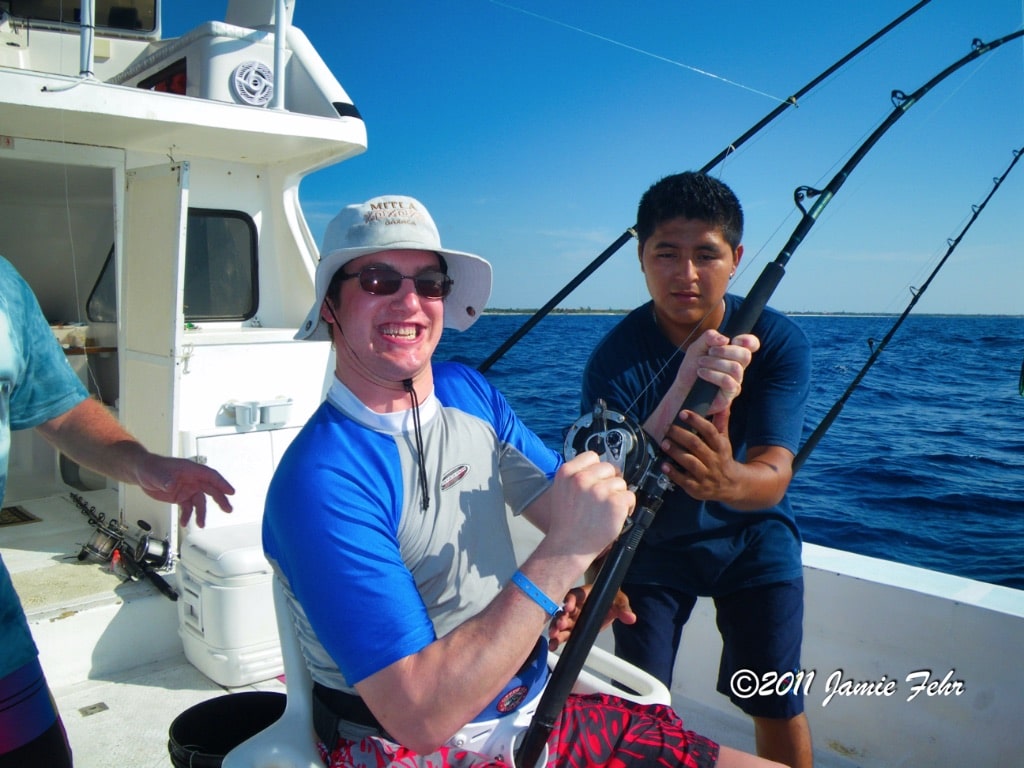

The day we went out, it was just the three of us, and three crew. Mike & I each caught a nice Sailfish. Boy, they sure do put up a good fight! And sometimes they leap into the air, showing you a glimpse of what you’ve got on your line. They were catch & release only, so we took a couple of quick photos before throwing them back.

After taking the picture with my Sailfish, my shirt was all slimy from the fish. That earned me the nickname for the rest of the day, and our trip, of “Slimy Jamie.” The Spanish pronunciation of my name, Jamie, is “hy-me.” So, my nickname rhymed, as in “Slimy hy-me.”
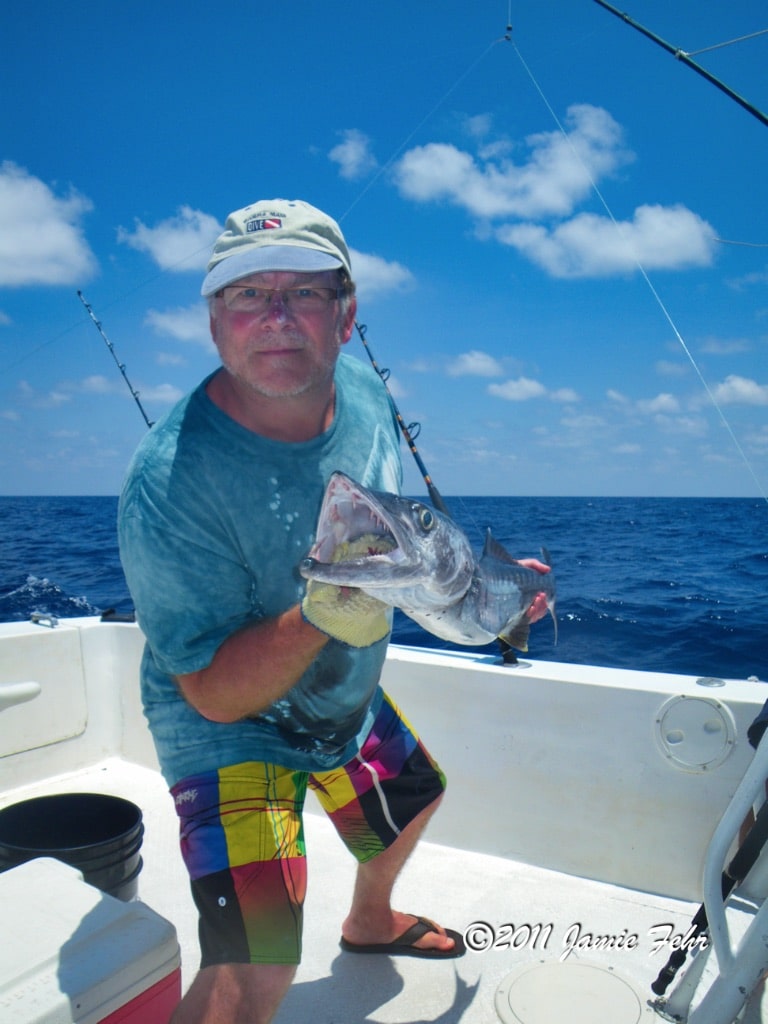
Larry caught a Wahoo, and fought it all the way to the boat, then as the first mate was trying to get it aboard, it spit the hook and got away. Aww, that was too bad. Next, Larry caught a Barracuda, which was the first fish we were allowed to keep. But they wouldn’t let us take any of its meat with us to eat. The Barracuda has toxins in its flesh that will poison those unfamiliar with them. It’s called Ciguatera fish poisoning. Check out this Wikipedia article for more info. But they told us that apparently their bodies had built up an immunity to those toxins, so they would enjoy eating that fish, and thanked us for catching it to provide them a meal.

The last catch of the day for our boat was a dorado fish, more commonly known by its Hawaiian name of Mahi-mahi, that I caught.
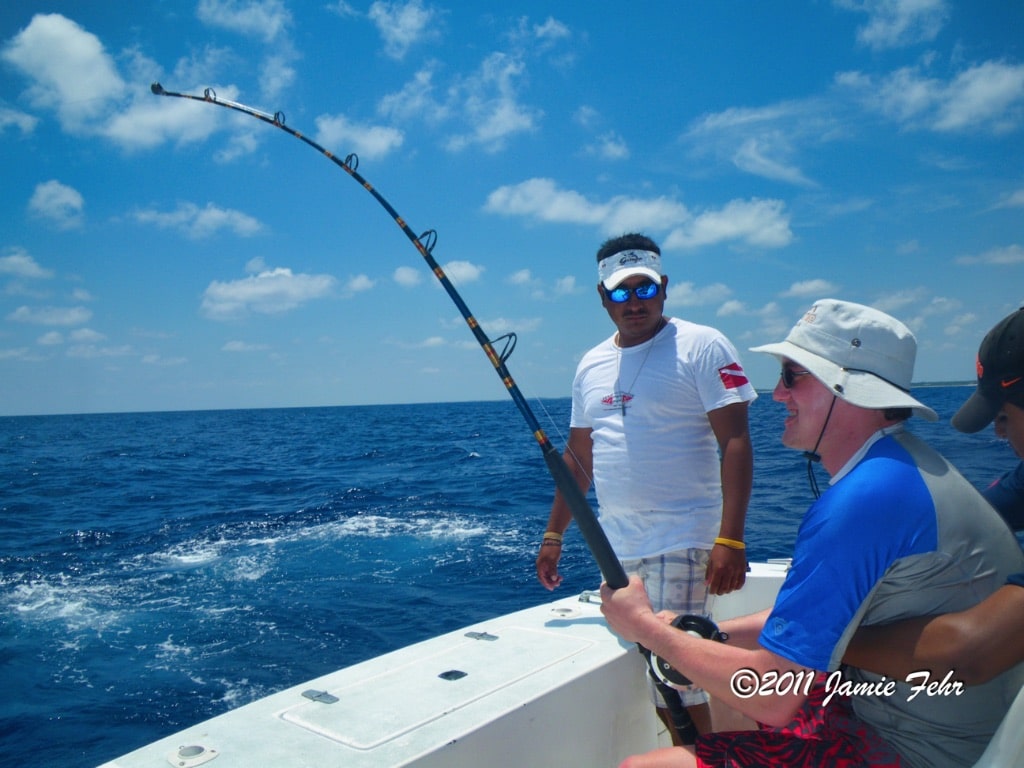

It was another exciting hook-up, and as I reeled the fish close to the boat, flashes of brilliant yellow and green were visible under the water, as the fish turned this way and that way as it fought. This only increased my excitement!

When it was finally gaffed and pulled into the boat, I was amazed at its brilliance and size. They said that it was a female (cow) that weighed about 45 lbs; that’s definitely the biggest fish I have ever caught, even to this day! Shortly after it died, so did most of its color. Here’s something interesting I learned about this fish, they don’t actually have any colors themselves, they have silvery skin and scales. But those scales are three-dimensional, and they reflect light like a prism. The Mahi-mahi isn’t always “lit up”, and is able to turn this on and off with signals from its nervous system. For more details check out this article. The author of that article uses another common name for Mahi-mahi, “dolphin fish.” This name is misleading, as these fish have nothing in common with dolphins (which are mammals), except for their saltwater habitat.
On the way back, the captain played some Bob Marley. Do you know how certain songs take you back to a memory? For me, “Buffalo Soldier” & “One Love” take me back to being on that boat. I remember it was sunny; the boat was rocking rhythmically as we were cruising along, and the tunes were blasting!

Upon our return, we were given Mahi-mahi steaks that they cut fresh for us right there on the dock. We brought them back to our resort, and asked the chef to cook them for us. His first question was if it was Barracuda. Once we assured him that it was Mahi-mahi, he said that he’d be delighted to cook it for us, and we decided on a time.

When our supper “reservation” time approached, we went to the restaurant. Keep in mind; this was a buffet-style restaurant, like most resorts have. But we didn’t go line up and get our own food. Shortly after the waiter confirmed we were there, out of the kitchen came three waiters, each with a giant tray on their shoulders. And following the waiters was the chef himself. As their procession made their way to our table, everybody else started looking, and some even wondered aloud why we were being treated so specially. In that moment, I felt like a king! We explained that we’d been out deep sea fishing earlier, and they had cooked our catch for us. Honestly, this was the best fish I have ever eaten, it was perfectly cooked!

At one of our last suppers there, the staff decided to have some fun. They brought over a few props and had us put them on/hold them. Then they took some pictures. Everybody, both the staff and us, were laughing heartily.
As you can see, we had a fabulous week! We made lots of fun memories, and thankfully, our return flights were uneventful. If my memory serves me correctly, it was at our layover in Houston where we had a meal at Bubba Gump Shrimp Co. It was my first time eating there, and it was delicious!
Watch for next month, when I’ll post a throwback to our honeymoon in Cuba!
Till next time, keep dreaming big!
» Jamie
“Never let your memories be greater than your dreams” – Douglas Ivester”
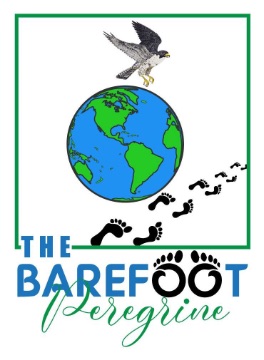
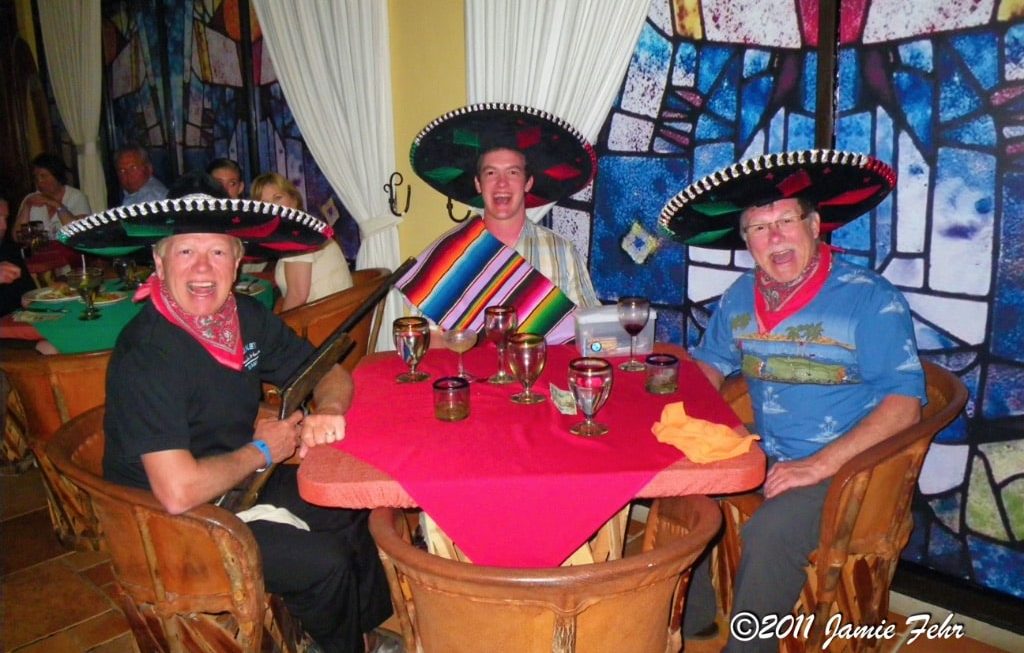
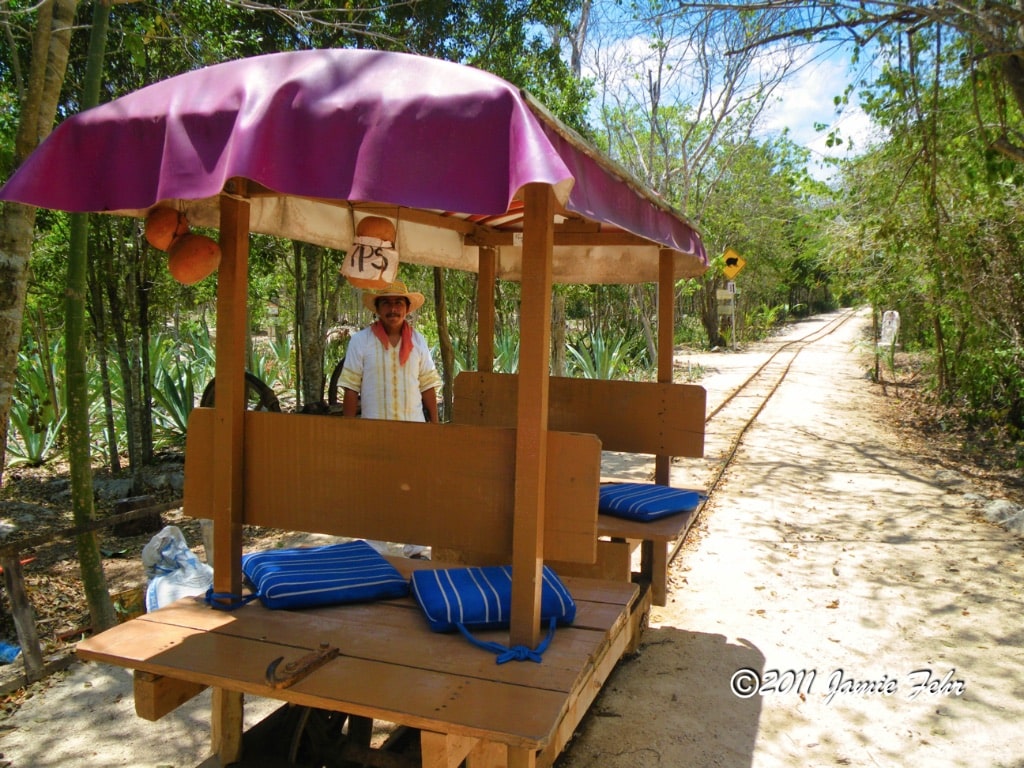
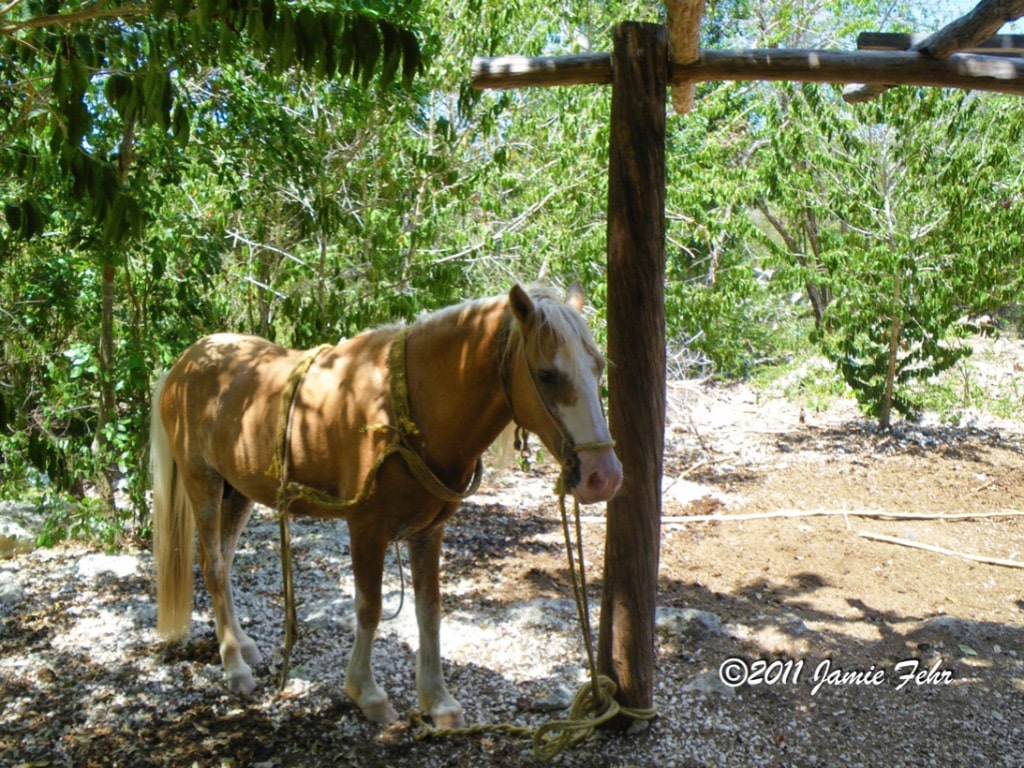


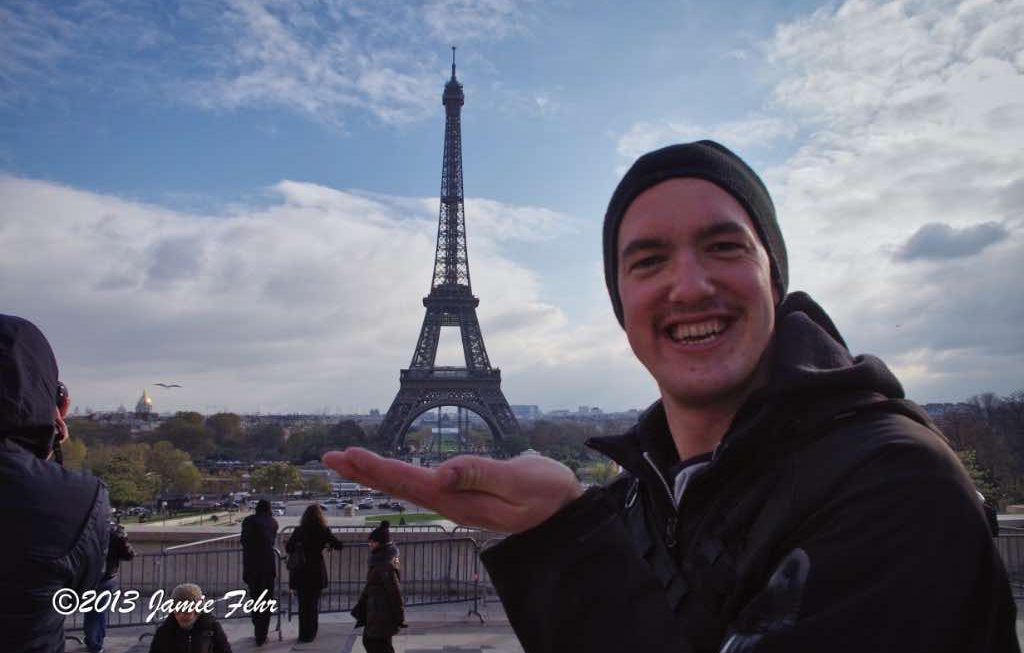
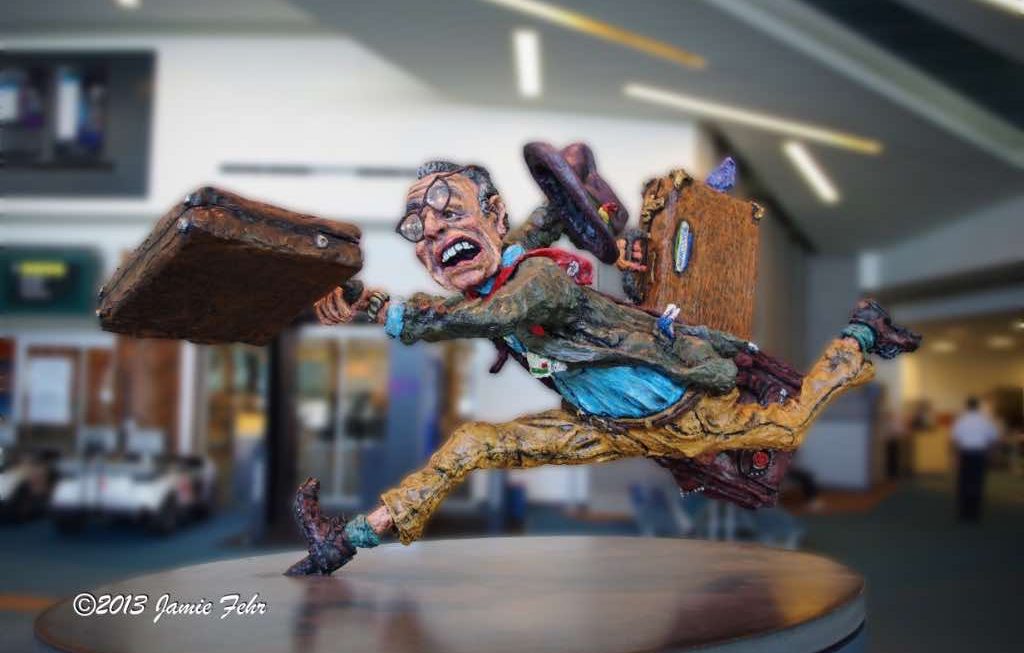
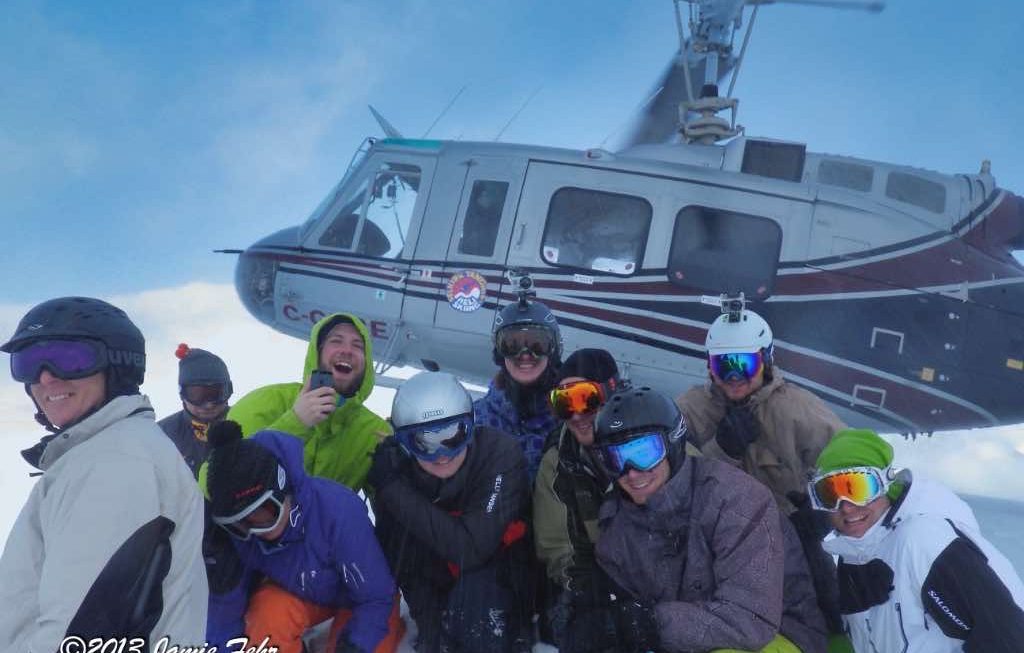
Great story! Very inspiring. It certainly makes me want to get back to the open water, and the open world! I enjoyed the Mahi Mahi fight. Keep up the good work!